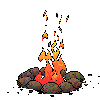|
This page represents just a brief introduction into the seven sacred ceremonies of the ancient Cherokee.

Cherokee ceremonies are held with the cycles of Mother Earth. During ceremony, positive
attitudes are far more important than rituals. Ceremonies offer opportunities for community worship, socialization, and bonding.
Ceremonial musical instruments used for dancing and festivals include drums, gourd rattles, and turtle shell rattles (leg
shackles). As part of worship, stomp dancing is held around the sacred fire and is accompanied by drums, singing, and leg
shackles worn by women. Other dancing occurred in a "square", a social area, usually around a center pole or social fire.
This was usually an area near the Council House, or the Long House. Our Cherokee ancestors tried to make each ceremony unique
in some way, they were creative. Music, dancing, feasting, stick-ball and storytelling were joyous expressions of thanksgiving
and occasions for Cherokee bonding at all cyclical ceremonies.
A sacred fire containing seven different types of wood, to represent the seven clans, was prepared and lit prior to ceremony
according to scared rites. Direction of movement around the sacred fire during Cherokee ceremony is counter-clockwise. A complete,
unbroken circle of "Red Heart" people around the fire produces powerful energy of the Creator's presence carried by the postitive
attitudes in the heart of the participants.

1. Great New Moon Ceremony - Celebrated at the first new moon in autumn (October). Since autumn was the season when Cherokee
stories say the world was created, it represented the new year celebration. Each family brought some produce from their field
to share, such as corn, beans and pumpkins. Ceremonies included dancing, purification by immersing seven times in water, called
"going to water". This ceremony gave the Cherokee an opportunity to give thanksgiving to the Great Spirit and the ancecestors
for their blessings on us. It was a time to feast, and give thanks to Creator that the cycle would continue.

2. Propitiation of Cementation Ceremony (Friendship Ceremony) - Celebrated 10 days after the Great New Moon Ceremony.
This ceremony symbolizes the unity between the Creator and mankind and also dealt with relationships between two people of
the same or opposite sex. These relationships were bonds of eternal friendship in which each person vowed to regard the other
as himself as long as they both lived. It was a ceremony that was a pledge of universal fraternal or paternal love. It also
entailed reconciliation between those who had quarreled during the previous year. It symbolized the uniting of the people
with the Creator and purification of body and mind. The New Moon Ceremony was said to have been the most profoundly religious
of all the ceremonies. As with other observances, it also involved the rekindling of the scared fire.

3. Bouncing Bush Ceremony (Exalting Bush Festival) - This was a joyous ceremony were the Cherokee expressed unrestrained
joy giving thanks to the Great Spirit and his helpers, acknowledging them as the source of our blessings. Dancing and feasting
abound, and thansgiving was expressed by everyone tossing an offering of sacred tobacco in the sacred fire.

4. First New Moon of Spring Ceremony - Celebrated in March, at the time the green grass began to grow. Fruits from the
previous fall harvest were brought to ceremony and consumed to remember the continuation of the Creator's care and blessing.
This festival initiated the planting season and incorporated predictions concerning crop success or failure. It lasted seven
days and included dancing and the re-lighting of the sacred fire by the "fire-keeper". There ceremony included sacrificing
a deer tongue in the fire. All the home fires were extinguished and rekindled from the sacred fire's coals, symbolizing fresh
beginnings, and renewal of life from Mother Earth.

5. Green Corn Ceremony - Celebrated in July or August, when corn is still green but fit to taste. New corn was
not to be eaten until after the ceremony took place. Messengers were sent to notify the towns of the nation about when the
celebration would take place. Along the way they gathered seven ears of corn, each from a field of a different clan. After
the messengers returned, the chief and seven councilors fasted for six days. The ceremony began on the seventh. Again, the
sacred fire was extinguished and rekindled. As the with the First New Moon Ceremony, a deer tongue was sacrificed in the sacred
fire. Kernels from the seven ears of corn that had been gathered from the clans were also sacrificed. Food that was made from
the new corn was brought to the town house and everyone was fed. The Chief and his councilors could only eat corn from the
previous year's crop for another seven days.

6. Ripe Corn Ceremony - Celebrated about 40 to 50 (late September) days after the Green Corn Ceremony, when the corn
is matured. It was the only ancient ceremony that survived into the 20th century. This is the end of the national cycle of
ceremonies. Thanksgiving is offered to the Creator for the harvest of mature, ripe fruit.

7. The Chief Dance (UKU Ceremony) - Celebrated once every seven years. The Principal Cherokee Chief is carried into the
Sacred circle of the Sacred Fire, on a white chair, and acknowledged as the Chief of all the people by each of the clans.
This ceremony reminds us of the one true Chief, the Great Spirit-Creator. Dancing and feasting follows.


|